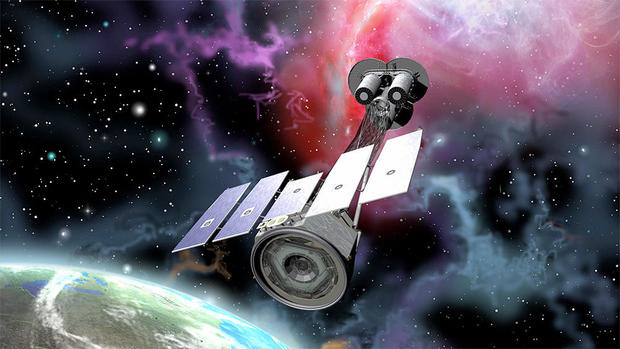SpaceX launches NASA X-ray telescope in company's 28th launch this year
Continuing an end-of-year launch surge, a SpaceX Falcon 9 rocket boosted a NASA X-ray telescope into orbit early Thursday to study the processes at work near collapsed neutron stars, black holes and other enigmatic bodies that trigger enormous outbursts of high-energy radiation.
The $214 million Imaging X-ray Polarimetry Explorer, or IXPE, is designed to focus on just one aspect of the X-rays emitted on or near its targets: the radiation's polarization.
"What is polarization? Well, if I'm an X-ray coming towards you, at right angles to the direction of motion is an electric field that oscillates back and forth," said Martin Weisskopf, the mission's principal investigator at NASA's Marshall Space Flight Center.
"If all the X-rays coming from the source have all of their electric fields in the same direction, they're 100 percent polarized. But if all of them have different angles with respect to the direction, they're unpolarized and somewhere in between."
By precisely measuring that polarization, scientists can determine how fast a black hole is spinning, for example, and glean other insights about the processes that generate X-rays near spinning neutron stars, or pulsars, supernova remnants, hugely magnetic stellar remnants known as magnetars and active galactic nuclei where supermassive black holes lurk.
"We will measure for very many sources," Weisskopf said. "So, a new toolkit for astronomy and astrophysics. Can't wait to see it work."
The mission got under way at 1 a.m. EST Thursday with a sky-lighting launch from historic pad 39A at the Kennedy Space Center. Liftoff came just one week after another Falcon 9 boosted a batch of Starlink internet satellites into orbit from the nearby Cape Canaveral Space Force Station.
That flight, SpaceX's 27th this year, set a record for the California rocket builder, and Thursday's launch pushed the total to 28 with at least two and possibly three more flights before the end of the year.
Thursday's flight went off without a hitch. IXPE was released into its planned circular orbit 335-miles above the equator 33 minutes after liftoff. The rocket's first stage, meanwhile, flew itself to a pinpoint landing on an off-shore drone ship to chalk up SpaceX's 97th successful booster recovery, it's 74th at sea.
While the Falcon 9's mission was complete, IXPE's was just getting started.
Originally designed to fit in the nosecone of a smaller rocket, the satellite, built by Ball Aerospace, features a compressed spine holding the three nested mirror assemblies needed to direct incoming X-rays to ultra-sensitive detectors provided by Italy.
If all goes well, commands will be sent to extend the boom in about a week, a make-or-break moment for the IXPE project.
"This is critical because due to the nature of X-rays and how we need to focus the light, the instruments have to be about 13 feet apart," said MacKenzie Ferrie, IXPE program manager at Ball Aerospace. "We build it to fit inside of the rocket, and that boom actually compresses down to about only 12 inches.
"So you've got this compact origami shape that the boom compresses into, and then it expands out and separates those mirrors from the instruments. And that's when we can start to take the the images and the polarimetry."
Weisskopf said the telescope is designed to study phenomena "that are very difficult for us to produce in our laboratories."
"We're talking about huge gravities like on the surface of a neutron star or near the border of black holes, huge magnetic fields ... 15 orders of magnitude more than the Earth's field, other processes that involve the production of X rays at these energies," he said.
"By doing this mission, we are adding two variables to the astrophysics toolkit to understanding the sources. That's the degree of polarization and the direction associated with the polarization."
Those data, in turn, may help scientist confirm or disprove competing theories about how some of the most energetic processes in the universe actually operate. But first, IXPE's boom must extend to precisely position the instrument's mirrors and detectors.






